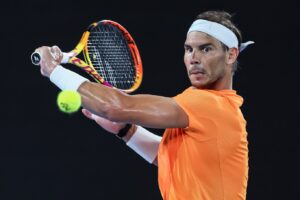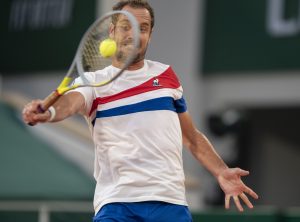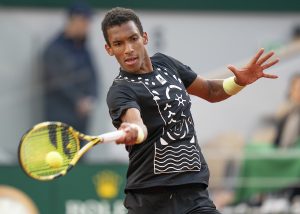Nick Kyrgios leads Daniil Medvedev in their head-to-head 3-1, and has a chance to add to that little bit of dominance on Sunday at the US Open. It’s unusual not only because Medvedev is the more accomplished and steady player, but because the Russian has a skillset that seems to match up well with everyone. He pushes Nadal to the brink every time they play, and has split his Slam finals matchups with Djokovic. He handles everyone else on tour, usually with relative ease, but Kyrgios has the better of him. What is it about the Aussie’s game that gives Medvedev so much trouble, and should we expect more of the same in their US Open Round 4 matchup?
Why Nick Kyrgios Is Such a Dangerous Matchup for Daniil Medvedev
To be fair, a four-match sample size is not very big, and if Medvedev wins it will sit at 3-2, which is entirely unremarkable. But Medvedev is such a player that anyone beating him at all warrants a closer look, much less beating him three times. And before we even dig into the reasons, the fact that we are talking about Nick Kyrgios almost answers the question without needing reasons. Kyrgios beats everyone when he tries. He beat the Big 3 as a teenager, he’s beaten two then-current world #1’s, and his pure physical skillset is often considered the best of his generation. So if anyone was going to hold a 3-1 record over Medvedev, it was either going to be a Big 3 or Nick Kyrgios.
Yin and Yang
But it’s more than just raw skill and general talent that Kyrgios brings to the matchup. He happens to play in almost exactly the opposite way of Medvedev. Medvedev has a big swatty forehand that he plays from deep behind the baseline; Kyrgios has an elbow-jackknifing, whippy forehand that he hits from near the court. Neither has a particularly remarkable backhand, although Medvedev has a remarkably awkward backhand motion, while Kyrgios gets by with a surprisingly short backswing. Medvedev uses the backhand well, especially with precision shots down the line, while Kyrgios doesn’t seem to consider it a weapon at all, and just sends his backhands back with little enthusiasm to await a more interesting shot.
Both players have a tendency to turn defense into offense, but offense seems to be Medvedev’s more natural groove, while Kyrgios seems to just want someone to challenge him so he can doing something fun. Medvedev speeds around the court in long gangly strides, but never goes out of his way to come to net; Kyrgios plays a low-energy variety of defensive tennis that seems mainly designed to stave off boredom, and looks more comfortable at the net than even Maxime Cressy. Medvedev exerts maximum energy, Kyrgios minimum, even when he is at his best.
But Why Would the Yang Trouble the Yin?
Naturally, then, two players with opposing skillsets might find it difficult to play against each other; but why would this favor Kyrgios? The answer is that it doesn’t necessarily. As we’ve said, four matches is not an extensive enough data set to say that one style should dominate the other. But there are aspects to Kyrgios’ game that can particularly trouble the Russian, and it all begins with Medvedev’s status. I don’t think anyone on tour looks forward to top-level matches more than Nick Kyrgios. Most players would have considered the walkover against Nadal in the semis of Wimbledon to be a gift, but Kyrgios looked legitimately disappointed in his press conference. His favorite thing in tennis seems to be testing himself against difficult competition, even more than specifically winning tournaments. Kyrgios might be the purest athlete on tour, whereas Nadal and Djokovic are probably the purest competitors.
The difference is where a player finds his pleasure—in the sheer physical joy of the game, or in the accomplishment of the win. To see more of this difference, contrast the two most famous tennis instructional books: The Inner Game of Tennis, by Timothy Gallwey, which focuses on unlocking physical potential by freeing the mind; and Winning Ugly by Brad Gilbert, which concerns itself simply with a victorious outcome. Different players bring different attitudes to the match, and Kyrgios probably more than anyone brings the attitude of a pure physical athlete.
So a better version of Kyrgios will tend to show up against Medvedev, and that is the dangerous version. Within that framework, then, we can see how the Aussie’s skillset matches up with the Russian’s. It is nearly impossible to play Medvedev from the baseline; he scrambles too well, he stays too far behind the baseline, he swats his forehand too hard and too accurately from back there, and he never gets tired. The only person who seems able to withstand his baseline rallying is Nadal, and there is only one Nadal. But that’s fine for Nick Kyrgios, because Kyrgios doesn’t care about baseline rallies. He doesn’t chase balls all over the back of the court. If he can’t wrist-flick a ball on the rise 90 mph into the corner, he’ll probably bring you to net, where his ridiculous combination of volleys, smashes, fakes, dinks, and angles will flummox any player except maybe Djokovic. And that’s why he can be such a menace to Medvedev.
For all Medvedev’s greatness, he doesn’t thrive at the net. He succeeds so well at the baseline because, like Nadal, he swings his racket from his shoulder; it creates a lot of power, and absorbs incoming pace well. But the shoulder muscle is not exactly the most touch-oriented muscle in the body. Kyrgios is all wrist and elbow, and there’s a lot of control there. Medvedev’s skills can be deceptive, because his incredible ability at 6’6” to reach the net and pick up drop shots could give someone the impression that he plays well at the net, but he is not at Kyrgios’s level there. It’s a weakness that doesn’t often get exposed, but that’s because there are few players on tour these days who can expose it.
Whose Style Will Dominate the Match?
The question of the day will be which player is able to lay his style over the other’s. It might come down to who serves better, and they are both excellent in that department. Medvedev has a chance to win if he is able to stay on the baseline, and if he is hitting his shots well, particularly his forehand down the line to Kyrgios’ backhand side. But if Kyrgios draws Medvedev forward, it will not only create favorable opportunities, but it could disrupt Medvedev’s rhythm and his focus. This match is not terribly unlike Nadal vs. Dustin Brown in that regard, and a disrupted rhythm can really mess with a player’s focus and skill. (For example, Medvedev was getting testy in the early stages of his first match against Maxime Cressy.)
Kyrgios is by no means guaranteed a win, but Medvedev drawing him in only the fourth round is a bit of bad luck. These days it seems that Kyrgios is favored over everyone but Nadal and Djokovic, and it was perhaps the greatest blow of the season that we didn’t get to see Kyrgios-Nadal at Wimbledon. This match here may end up being the best of the tournament, as both players should be very motivated, and the crowd should be highly invested as well. The intrigue of a Kyrgios run is great, and the skillset matchup is a clash of styles. And whichever way this particular match goes, the rivalry should be a good one as long as Kyrgios stays motivated to compete at a high level, given the particular blend of skills and elite talent that he brings to the matchup.
Main Photo:
Embed from Getty Images






